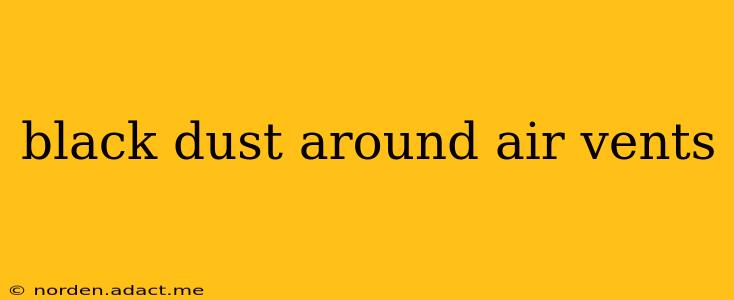Finding black dust around your air vents is unsettling. It suggests something's amiss within your home's HVAC system or environment, potentially impacting your indoor air quality and even your health. This comprehensive guide explores the common causes of this issue, effective solutions, and preventative measures to keep your home clean and your air healthy.
What Causes Black Dust Around Air Vents?
Several factors can contribute to the appearance of black dust near your air vents. Identifying the source is crucial for effective remediation. The most common culprits include:
-
Mold: Damp environments are breeding grounds for mold, which can appear as black or dark-colored spores. If you notice a musty odor alongside the black dust, mold is a strong suspect. Mold spores are a significant concern for respiratory health, making prompt identification and removal paramount.
-
Mildew: Similar to mold, mildew thrives in humid conditions. It often presents as a black or dark grey film, especially in areas with poor ventilation. Like mold, mildew can trigger allergies and respiratory problems.
-
Dust Mites: While not typically black in color, dust mite droppings can contribute to a dark residue, particularly if combined with other dust and debris. These microscopic creatures are prevalent in homes and are a common allergen.
-
Combustion Byproducts: If the black dust is particularly sooty or greasy, it could indicate incomplete combustion in your furnace or other heating appliances. This is a serious issue that requires immediate professional attention. Incomplete combustion produces carbon monoxide, a highly toxic gas.
-
Dirt and Debris: Simple dust and dirt accumulating from daily life can appear darker in color, especially if mixed with other substances like pet dander or pollen. Regular cleaning and air filter changes can minimize this.
-
HVAC System Issues: A failing or poorly maintained HVAC system can circulate dust and debris throughout your home. Dirty air filters, clogged ducts, or a malfunctioning blower motor can all contribute to the problem.
How to Clean Black Dust Around Air Vents?
Cleaning the immediate area around your air vents is a crucial first step, but it's only a temporary fix. You need to address the root cause for long-term results.
-
Vacuuming: Begin by thoroughly vacuuming the vents and the surrounding area using a brush attachment to remove loose dust and debris. A HEPA-filter vacuum is recommended to capture fine particles effectively.
-
Wiping: For stubborn dust or stains, gently wipe the vent covers with a damp cloth and mild detergent. Ensure the vents are completely dry before replacing them.
-
Professional Cleaning: For significant accumulation or if you suspect mold or mildew, it's best to contact a professional HVAC cleaning service. They possess the expertise and equipment to safely and thoroughly clean your ductwork and HVAC system.
How Often Should I Clean My Air Vents?
The frequency of air vent cleaning depends on various factors, including your home's environment, the number of occupants, and the presence of pets. However, a general guideline is to clean your vents at least twice a year, ideally in spring and fall. More frequent cleaning may be necessary if you notice significant dust accumulation or other issues.
What Can I Do to Prevent Black Dust Buildup?
Prevention is key. Here are some proactive measures to reduce the risk of black dust accumulating around your air vents:
-
Regular Air Filter Changes: Change your HVAC air filters regularly, as recommended by the manufacturer. This is the simplest and most effective way to prevent dust and debris from circulating throughout your home.
-
Regular HVAC Maintenance: Schedule annual professional inspections and maintenance for your HVAC system. This will identify potential issues early and prevent them from worsening.
-
Improve Indoor Air Quality: Use air purifiers with HEPA filters to remove allergens and pollutants from the air. Ensure proper ventilation in your home to reduce humidity and prevent mold growth.
-
Address Moisture Issues: Repair any leaks promptly and address sources of excess moisture, such as damp basements or leaky pipes. This helps prevent the growth of mold and mildew.
Is Black Dust Around Air Vents Harmful?
The health risks associated with black dust around your air vents depend on the source of the dust. If the dust contains mold spores, mildew, or combustion byproducts, it can trigger allergies, respiratory problems, and other health issues. In severe cases, it may even be toxic. If you experience any respiratory symptoms or health concerns, consult a medical professional immediately.
What Should I Do if I Suspect Mold or Mildew?
If you suspect mold or mildew, it's crucial to address the problem promptly. Do not attempt to clean it yourself if the infestation is extensive, as this could spread spores and worsen the issue. Contact a professional mold remediation specialist who has the proper equipment and expertise to safely remove the mold and remediate the affected areas. Remember, always prioritize safety when dealing with potential mold or mildew issues.
